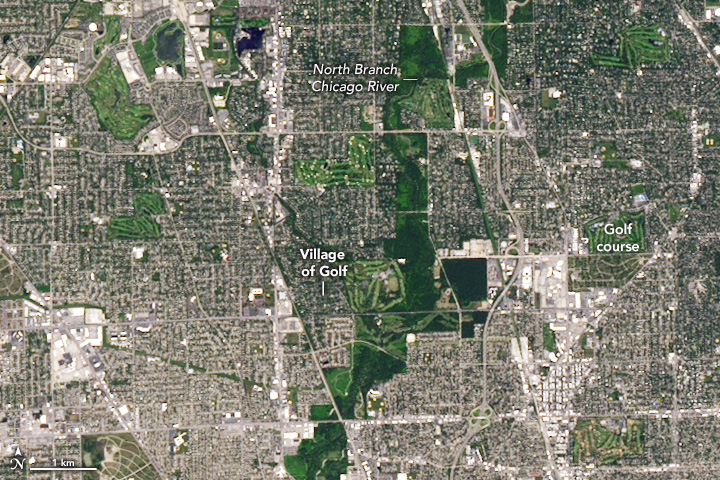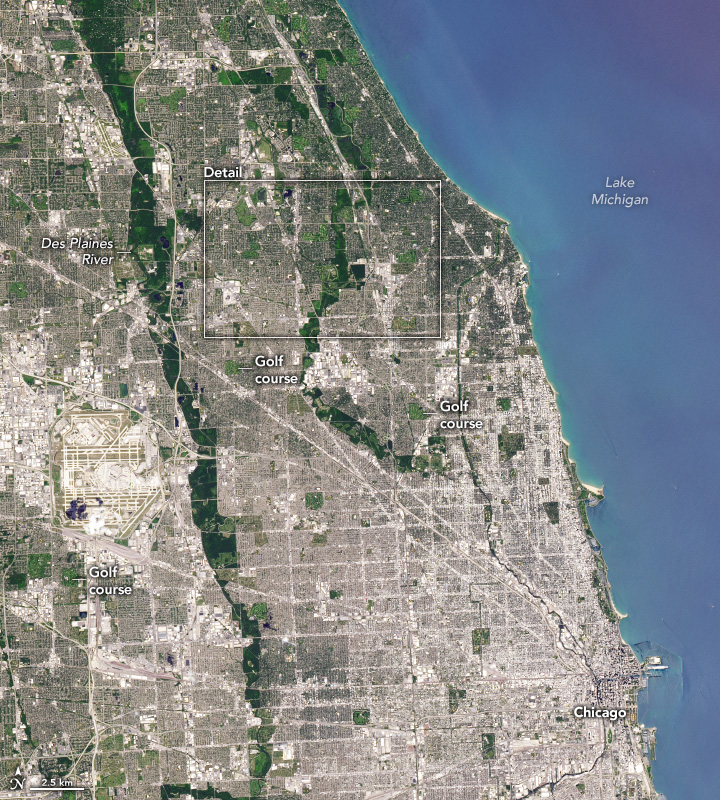Golfing in Illinois

Today’s story is the answer to the August 2024 puzzler.
The suburbs north and west of Chicago contain golf courses—lots of them. At least ten courses dot the landscape in the Landsat 8 image above, captured by the OLI (Operational Land Imager) on June 14, 2024. The image below shows a broader view of the same image, with dozens of courses visible.
The short grasses in the fairways appear as the caterpillar-shaped light-green features flanked by the darker greens of the rough—often tall fescue or other grass varieties that are allowed to grow to a greater height. In satellite imagery, many courses are speckled with bright and dark patches, the water and sand hazards that golfers avoid.
Despite the large number of golf courses in this part of Cook County and in the region more broadly, other U.S. metro areas have an even higher density of courses per capita. The Naples-Immokalee-Marco Island area in southwestern Florida ranks especially high, according to one analysis of U.S. Bureau of Labor Statistics data. Florida is also the state with the most golf courses in total (1,262), according to the National Golf Foundation. That’s 31 percent more than California, the state with the second-most courses. Outside the U.S., only three countries have more than the state of Florida: Japan, the United Kingdom, and Canada.
But there’s one other way this part of Illinois stands out that golfers will appreciate. It’s home to the village of Golf, a small community of 160 households west of Glen View Club, one of the oldest 18-hole courses in the United States. The local train station—and later the village—were named Golf, in part because Albert Earling, a member of Glen View Club and the president of the Chicago, Milwaukee, and St. Paul Railroad company, had the company establish a special train station where he could unhitch his private train car from trains going north before hitting the greens, according to Golf Magazine.
Though numbers have declined in recent decades, the U.S. still had around 16,000 golf courses as of 2024, or about 42 percent of the world’s total. The game requires a large amount of space compared to other sports—about five times more per player than doubles tennis and 37 times more per player than basketball.
All those golf courses cover about 2 million acres, or less than 0.1 percent of the U.S. land surface area. That’s still an area larger than the state of Delaware and more than all the land used to raise Christmas trees, according to an analysis of U.S. land use conducted by Bloomberg. For comparison, the amount of land devoted to feeding livestock, the largest use of land in the U.S., spanned 781 million acres, or 41 percent of the contiguous U.S., the analysis concluded. The analysis was based, in part, on the National Land Cover Database, which is built on satellite observations from the Landsat program, a series of Earth-observing missions jointly managed by NASA and the U.S. Geological Survey.
NASA and the sport of golf have intersected in intriguing ways over the decades. NASA’s honing of an innovative type of threading technology in the 1980s to make screws on the International Space Station extra resistant to vibration eventually led to a sporting goods company achieving the lowest-ever center of gravity in a golf club, NASA Spinoff reported.
A famous connection to the game came in 1971, when astronaut Alan Shepherd attached a 6-iron head to a tool designed to pick up lunar rock samples and hit two golf balls from the surface of the Moon. Shepherd shanked the first shot into a nearby crater but hit the second ball more solidly, propelling it “miles and miles and miles,” the astronaut joked at the time. Three decades later, image restoration by science writer Andy Saunders worked out the exact distances that each of Shepherd’s “moon shots” flew: 24 yards (22 meters) for ball number 1 and 40 yards (37 meters) for ball number 2, Saunders reported in a story for the United States Golf Association.
How far could a golfer theoretically hit a golf ball on the Moon if they were unencumbered by a space suit, like Shepherd was? “If 2016 PGA champion and space enthusiast Jimmy Walker replicated his Earthbound ball speed of 185 miles per hour on the Moon, and used a club that would ensure a 45 degree launch angle, it would travel 2.62 miles (4,611 yards) and stay in the air for more than one minute,” Saunders wrote. “Literally, ‘miles and miles and miles…’.”
NASA Earth Observatory images by Wanmei Liang, using Landsat data from the U.S. Geological Survey. Story by Adam Voiland.
Related
Home of Cincinnati Reds turns into golf course for a…
CINCINNATI (WXIX) - Cincinnati Reds fans will have an opportunity to play golf at Great American Ball Park (GABP) this summer.For the second year in a row, Uppe
Arnold Palmer Invitational Livestream: How to Watch the Golf Tournament…
Dozens of the world’s top golfers are headed to Orlando’s Bay Hill Club and Lodge for the 2025 Arnold Palmer Invitational — here’s where to s
PGA Tour Driving Distance Leader Dunks One of Year’s Shortest…
Last week plenty of fans took issue with how PGA National's Champion course, typically one of the toughest on the PGA Tour, played easy in the first few rounds.
How to watch LIV Golf Hong Kong 2025: Date, time,…
LIV Golf is making its return to Hong Kong for the second year in a row. Keep reading for more information on dates, times, how to watch, and more (all time













